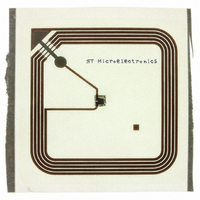SRI512-A3S/1GE STMicroelectronics, SRI512-A3S/1GE Datasheet - Page 26

SRI512-A3S/1GE
Manufacturer Part Number
SRI512-A3S/1GE
Description
IC MEMORY 13.56MHZ EEPRM ADH ANT
Manufacturer
STMicroelectronics
Series
SRI512r
Specifications of SRI512-A3S/1GE
Rf Type
Read / Write
Frequency
13.56MHz
Features
ISO14443-B
Package / Case
38mm x 38mm
Operating Temperature (max)
85C
Operating Temperature Classification
Commercial
Lead Free Status / RoHS Status
Lead free / RoHS Compliant
Other names
497-5535-2
Anticollision
7.1
Table 4.
26/47
Step 1
Step 2
Step 3
Step 4
Step N
Step 17 Slot 15
Step 18
Init:
Slot 0
Slot 1
Slot 2
Slop N
Description of an anticollision sequence
The anticollision sequence is initiated by the Initiate() command which triggers all the
SRI512 devices that are present in the reader field range, and that are in Inventory state.
Only SRI512 devices in Inventory state will respond to the Pcall16() and Slot_marker(SN)
anticollision commands.
A new SRI512 introduced in the field range during the anticollision sequence will not be
taken into account as it will not respond to the Pcall16() or Slot_marker(SN) command
(Ready state). To be considered during the anticollision sequence, it must have received the
Initiate() command and entered the Inventory state.
Table 4
example.)
Standard anticollision sequence
After each Slot_marker() command, there may be several, one or no answers from the
SRI512 devices. The reader must handle all the cases and store all the Chip_IDs, correctly
decoded. At the end of the anticollision sequence, after Slot_marker(15), the reader can
start working with one SRI512 by issuing a Select() command containing the desired
Chip_ID. If a collision is detected during the anticollision sequence, the reader has to
generate a new sequence in order to identify all unidentified SRI512 devices in the field. The
anticollision sequence can stop when all SRI512 devices have been identified.
Send Initiate().
– If no answer is detected, go to step1.
– If only 1 answer is detected, select and access the SRI512. After accessing the SRI512,
– If a collision (many answers) is detected, go to step2.
Send Pcall16().
– If no answer or collision is detected, go to step3.
– If 1 answer is detected, store the Chip_ID, Send Select() and go to step3.
Send Slot_marker(1).
– If no answer or collision is detected, go to step4.
– If 1 answer is detected, store the Chip_ID, Send Select() and go to step4.
Send Slot_marker(2).
– If no answer or collision is detected, go to step5.
– If 1 answer is detected, store the Chip_ID, Send Select() and go to step5.
Send Slot_marker(3 up to 14) ...
– If no answer or collision is detected, go to stepN+1.
– If 1 answer is detected, store the Chip_ID, Send Select() and go to stepN+1.
Send Slot_marker(15).
– If no answer or collision is detected, go to step18.
– If 1 answer is detected, store the Chip_ID, Send Select() and go to step18.
All the slots have been generated and the Chip_ID values should be stored into the
reader memory. Issue the Select(Chip_ID) command and access each identified
SRI512 one by one. After accessing each SRI512, switch them into Deselected or
Deactivated state, depending on the application needs.
– If collisions were detected between Step2 and Step17, go to Step2.
– If no collision was detected between Step2 and Step17, go to Step1.
deselect the tag and go to step1.
shows the elements of a standard anticollision sequence. (See
Doc ID 13263 Rev 5
Figure 22
for an
SRI512













